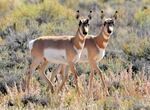
A pair of twin pronghorn fawns, brother and sister, on Seedskadee National Wildlife Refuge, Sept. 24, 2019. Brother on the left and sister on the right.
Tom Koerner/USFWS/Flickr
Sixty-eight-year-old Julie Weikel and two of her friends have just returned from a five-day trek covering 53 miles in the high desert of Eastern Oregon. Their trek was different from many, not just because Weikel and her friends are a bit older than you might expect — Helen Harbin is 65, and Alice Elshoff is 80 — but also because this was a hike with a mission: to confirm the migration pattern of Pronghorn Antelope between the Hart Mountain and Sheldon National Wildlife refuges. Julie Weikel spoke with "Think Out Loud" host Dave Miller about the trip.
Weikel says the wildflowers alone were breathtaking. "The panoramas of yellows and purples and blues and whites and creams just ebbed and flowed continuously for days. It was spectacular."
She says she and her small group knew that about 3,500 Pronghorn live between and on the two refuges, and even though they expected to see the animals, it was pretty exciting to see them in person.
"They're usually first inquisitive and curious, especially since we're walking through their landscape and they're not real used to that, so there's this, 'What are you doing here?' kind of stance. And they size us up for a while and then they flash their big, white fannies and head off over the horizon and put on a show."
Weikel says since the two refuges were created in the early part of the last century, scientists now know that this ecosystem is important to many more species besides just the Pronghorn Antelope.
"Fish and Wildlife has identified this as a primary and major place that needs to be preserved for sage grouse to survive."
She says there's all sorts of human activity that could "fragment" the landscape and threaten conservation, including mining, fires, invasive species and roads.
Weikel is a retired large animal veterinarian who says she's been involved with wildlife and conservation efforts for decades. She says even though she's getting older, it's worth the extra effort it takes for her to get out into the wild.
"When you reach a point in your life where there's kind of like daily aches and pains, that when you get in those spectacular environments, that whole panorama of minor aches and pains just kind of fades into the background, your step just gets lighter, and lo and behold at the end of the day your GPS says you did over 10 miles today and it doesn't feel too hard."
Here's a Fish & Wildlife video that shows some of the terrain — and some of the Pronghorn — that Julie Weikel and her friends witnessed over the last five days.
